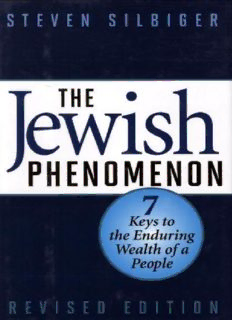
The Jewish Phenomenon: Seven Keys to the Enduring Wealth of a People PDF
Preview The Jewish Phenomenon: Seven Keys to the Enduring Wealth of a People
Seven Keys to the Enduring Wealth of a People Revised Edition Steven Silbiger Acknowledgments ix Introduction 1 I Understand That Real Wealth Is Portable; It's Knowledge 21 2 Take Care of Your Own and They Will Take Care of You 35 3 Successful People Are Professionals and Entrepreneurs 53 4 Develop Your Verbal Confidence 87 5 Be Selectively Extravagant but Prudently Frugal 107 6 Celebrate Individuality: Encourage Creativity 127 7 Have Something to Prove: A Drive to Succeed 157 Appendix 1: Yiddish: "Can't Spell It, Can't Pronounce It, and Don't Get it" 175 Appendix 2: Hebrew: Fifty Helpful Vocabulary Words 191 Appendix 3: Ten Yiddish Proverbs 195 Appendix 4: The Jewish Calendar and Jewish Holidays 197 Notes 201 Humor Sources 209 Index 211 Ywould like to thank John Yow, my editor at Longstreet Press, who immediately saw the potential of the project and made invaluable contributions to the book. I would also like to thank my editors who provided me a greater sensitivity and perspective: John Braun, Helen Gioulis and Rachel Silbiger, my mom. Comments, questions? E-mail the author at [email protected]. JJteven Spielberg. Ralph Lauren. Sergey Brin. Michael Dell. They're all successful, at the top of their fields. They're all fabulously wealthy. And they're all Jewish. Those three characteristics-successful, wealthy and Jewish-are linked repeatedly in America today. And it is no accident. Jewish Americans are, as a group, the wealthiest ethnic group in America. But the factors that work together to create Jewish wealth, which I identify in this book, can be applied to individuals and groups from any background. When this book was originally written both The Millionaire Next Door and The Gifts of the Jews shared the Neu, York Times best-seller lists. But despite this obvious interest in wealth, on one hand, and the Jewish people, on the other, the two subjects have not been dealt with together. The Gifts of the Jews confines its discussion to the contributions that Judaism has made to American culture, including monotheism, the Ten Commandments and the Sabbath. But what largely defines Jews in the popular imagination is their economic success and the accomplishments that made it possible. Perhaps Jews and their wealth have not become a focus for discussion because whenever Americans discuss ethnicity and money, the conversation tends to become heated. It does not have to be that way. The extraordinary story of Jewish-American success contains lessons for all of us. Many authors have written books about business success, trying to find a pattern that we can apply to all business organizations. What makes a company successful? Disney, Coca-Cola, Procter & Gamble, Google ... how have they overcome challenges and become so successful? In examining the phenomenon of Jewish-American success, this book reveals the principles that can be applied to your life. And it is important to note that the wealth created by Jews is much more than just money; it includes advances in the arts, sciences and humanities that made the money possible. A recent Los Angeles Times article describes the gap that The Jewish Phenomenon bridges. "The easy temptation is just to offer a laundry list of Jews and their achievements-a Hall of Fame of Nobel Prize winners, musicians and artists, a parade of business leaders, movie moguls, educators, journalists and entertainers who have influenced the American scene. Yet in searching for a deeper answer to the question-a theory that might explain the contributions of people as diverse as Howard Stern and Albert Einstein-there's a silence in the literature about Judaism and American life." The seven "keys" described in this book bring the silence to an end. About half of American Jews marry gentiles, prompting experts to project that the Jewish-American community will shrink to half its size by 2050. This statistic lends urgency to the investigation of Jewish success today. As Rabbi David Wolpe of Sinai Temple, the oldest Conservative Jewish congregation in Los Angeles, explained to the writer for the Los Angeles Times, "The farther away you get from the source of your tradition, the less of a contribution you might be expected to make in a place like America. We could lose something precious." The Bell Curve, published with a storm of controversy in 1994, went down a slippery slope by examining the genetic IQ component of the success ofJews and other groups-an approach that alienated Jews and Gentiles alike. During the debate over The Bell Curve, the Union of American Hebrew Congregations rightly stated, "As Jews, we know too well how these theories have been used against us ... to justify hatred, discrimination, even murder and genocide."' The Bell Curve's sharp rhetoric and dense statistics serve no useful purpose for two reasons: the science does not pass critical review, and there would be nothing to be learned if success lay in our genetic code at birth. The Jewish Phenomenon takes a positive position, that the Jewish people have been successful because of a combination of factors related to the Jewish religion and culture, and a collective historical experience. These are things that everyone and any group can examine and learn from. Anti-Semitism has a long history, and it is by no means dead. Throughout that long history, the Jews' success has been decried as the reason for other people's problems. Even President Richard Nixon, in his Watergate paranoia, saw the Jews as his enemies. In the famed "Nixon Basement Tapes," Nixon told chief of staff H. R. Haldeman, "What about the rich Jews? The IRS is full of Jews, Bob. Go after 'em like a son-of-a-bitch! "While institutional antiSemitism has been virtually eliminated in America, on a personal level antiSemitism is very much alive.
Description: